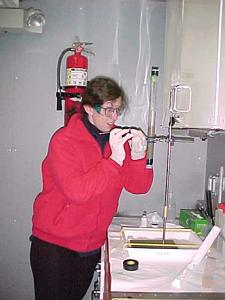13 March, 2000
Today has been foggy but much calmer. The temperature is still at 3
degrees. The sampling work is going much smoother without the waves.
Much of the analysis of the samples will take place back at the
scientists universities and laboratories. There are scientists and
graduate students on this cruse from: University of Hawaii, N.C.
State University, Rutgers, Texas A&M, and the Natural History Museum
in London, England.
Dr. Hilary Hartnett is working with sulfur fixing bacteria from the
sediments. Her BS in Chemistry from Vassar and her Masters and PhD.
in Oceanography from University of Washington have prepared her for
this work. She first takes a subcore from the larger sediment cores
brought up from the ocean bottom with the megacorer. The sediments
contain bacteria which use sulfur instead of oxygen to metabolize
nutrients. If the amount of sulfur used by these bacteria is
measured this data can then be used to help determine how fast the
nutrients in the sediments are being metabolized. The problem is
that there is too much sulfur in the ocean water to accurately detect
rates of change in the amounts. Dr. Hartnett uses a radioactive
isotope of sulfur which can be traced to solve this problem. She
injects the measured amount radioactive sulfur into the sediment
sample each centimeter and stores the sample at ocean bottom
temperatures (about 1.5 degrees Celsius). The rate of change in the
known amount of radioactive sulfur can now be measured. This is done
in a laboratory in Germany. The data is used to determine the
nutrient uptake by these bacteria which is important in answering the
questions of how long the nutrients from the summer increase in
organisms and activity remain available for metabolism throughout the
rest of the year, one of the questions of this research.
Dr. Hartnett does all of her work on deck in a small container lab.
Even though the level of radiation is low, she follows the safety
protocol for working with a radioactive isotope.

Dr. Hartnett injecting radioactive sulfur into a sediment subcore.
Contact the TEA in the field at
.
If you cannot connect through your browser, copy the
TEA's e-mail address in the "To:" line of
your favorite e-mail package.
|
